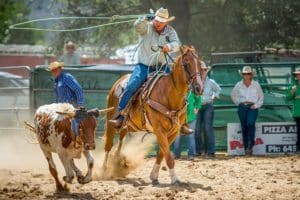Equine Joint Health: Top Therapies for a Successful Season
What joint therapy (if any!) is right for your horse?

With the summer show season just around the corner, now is the time to start preparing your horses for success. However, diving into intense training can take a toll on your horses’ joints, potentially leading to issues right when you need them performing their best.
In this article we’ll learn how common joint issues, primarily osteoarthritis (OA), concern owners of competitive horses. Then we’ll look at preventive and therapeutic approaches to manage this chronic, invariably progressive performance-limiting condition.
Why Focus on Equine Joint Health?
Results from several recent studies reveal that many horse owners view musculoskeletal conditions as a major health concern. For example, in one survey of 246 horse owners, researchers found that 29.2% of survey respondents listed stiffness and reduced leg/joint flexibility as a major concern (Herbst et al., 2024). Osteoarthritis was the most common owner-reported, veterinary-diagnosed medical condition, occurring in 32.6% of horses owned by survey respondents. That survey included horses 15 years or older actively involved in low-, medium-, and even high-level (international) competition.
Another research group conducted an online survey of 1,677 owners of British eventing horses about lameness and illness (Tranquille et al., 2024). Of those, 26% relayed having a lameness/musculoskeletal issue in the previous six months, with joints being the second most frequent source of the lameness (382 horses). The most commonly affected joints included the tarsus (hock), stifle, forelimb distal interphalangeal (coffin) joint, metacarpophalangeal (forelimb fetlock) joint, and the carpus (knee).
Joint issues disrupt training and competition. In the Tranquille et al. survey, owners reported that horses with fetlock and hock injuries were off work for about two weeks. Stifle and coffin joint problems often required layups of up to six months.
Preventing OA, Slowing Progression for Equine Joint Health
Osteoarthritis often begins with low- to medium-grade inflammation (i.e., synovitis or inflammation of the joint’s inner lining) where there might not be any cartilage or bone changes.
“But if left unchecked, this condition can progress, affecting other tissues in the joint, including the cartilage lining the ends of bones inside joints and the layer of bone directly under the cartilage called the subchondral bone,” explains Laurie Goodrich, DVM, PhD, Dipl. ACVS, professor of surgery and lameness at Colorado State University’s (CSU) Johnson Family Equine Hospital and director of the Orthopaedic Research Center, in Fort Collins. “As OA advances, the cartilage and subchondral bone lose their ability to support the necessary mechanical forces that are required of them.”
“Ultimately, OA permanently changes the joint environment where cartilage is thinned or lost, the bone underneath it becomes thickened (sclerotic), the joint capsule loses its pliability, and the joint becomes stiff. These are all characteristics of career-limiting OA,” says Goodrich
This story requires a subscription to The Horse magazine.
Current magazine subscribers can click here to and continue reading.
Subscribe now and gain unlimited access to premium content.
Subscribe NowWe at The Horse work to provide you with the latest and most reliable news and information on equine health, care, management, and welfare through our magazine and TheHorse.com. Our explanatory journalism provides an understandable resource on important and sometimes complex health issues. Your subscription will help The Horse continue to offer this vital resource to horse owners of all breeds, disciplines, and experience levels.

Related Articles
Stay on top of the most recent Horse Health news with

















